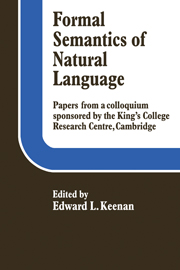Book contents
- Frontmatter
- Contents
- Notes on the contributors
- Acknowledgements
- Introduction
- I QUANTIFICATION IN NATURAL LANGUAGE
- Adverbs of quantification
- Deletion and variable binding
- A semantics for superficial and embedded questions in natural language
- Sortal quantification
- II REFERENCE AND CROSS REFERENCE
- III INTENSIONAL LOGIC AND SYNTACTIC THEORY
- IV QUESTIONING MODEL THEORETIC SEMANTICS
- V PRAGMATICS AND SENTENCES IN CONTEXT
- VI SEMANTICS AND SURFACE SYNTAX
A semantics for superficial and embedded questions in natural language
Published online by Cambridge University Press: 05 November 2011
- Frontmatter
- Contents
- Notes on the contributors
- Acknowledgements
- Introduction
- I QUANTIFICATION IN NATURAL LANGUAGE
- Adverbs of quantification
- Deletion and variable binding
- A semantics for superficial and embedded questions in natural language
- Sortal quantification
- II REFERENCE AND CROSS REFERENCE
- III INTENSIONAL LOGIC AND SYNTACTIC THEORY
- IV QUESTIONING MODEL THEORETIC SEMANTICS
- V PRAGMATICS AND SENTENCES IN CONTEXT
- VI SEMANTICS AND SURFACE SYNTAX
Summary
We shall propose in this paper a formal semantics for elementary embedded questions, such as John knows which student Mary invited, John can't remember who left early, etc. The semantics for these sentences will be stated in terms of that for the corresponding ‘direct’ questions, e.g. Which student did Mary invite?, Who left early?, etc. So I shall first review the semantics of elementary direct questions, as proposed in Keenan and Hull (1973), and then generalize the analysis to cover the case of embedded questions:
Direct questions
The intuition
We consider a question such as (1):
(1) Which student did Mary invite?
to be basically a request for the identification of the student who Mary invited. An answer to the question is, linguistically, a noun phrase that refers to that individual. It might be an alternative description such as the student who won first prize, or perhaps just an elementary referring expression such as John, or even him. If the noun phrase does refer to the student in question, then it is a true answer to the question; otherwise, it is not.
In our semantics, then, question-answer pairs determine truth values. Questions themselves are, semantically, the sort of thing that makes a proposition from an answer phrase, but they do not themselves carry truth values. The basis of our semantics of questions lies in the definition of truth and falsehood for question-answer pairs – that is, in the definition of the question-answer relation.
- Type
- Chapter
- Information
- Formal Semantics of Natural Language , pp. 35 - 45Publisher: Cambridge University PressPrint publication year: 1975
- 20
- Cited by

